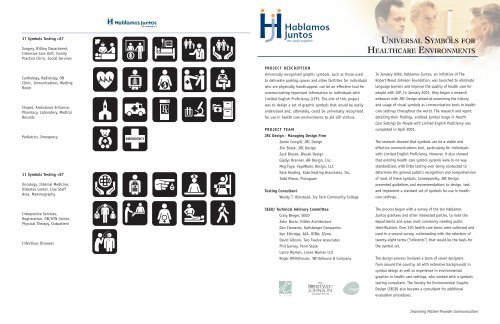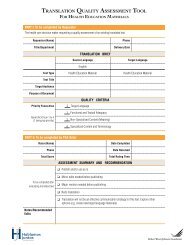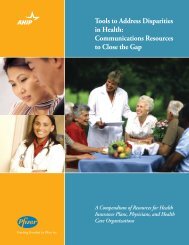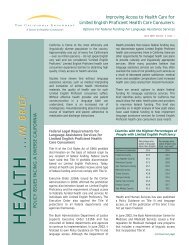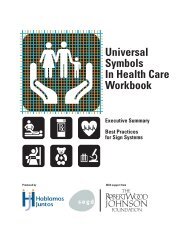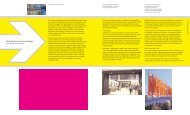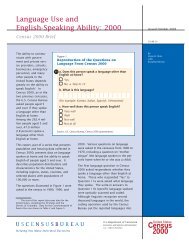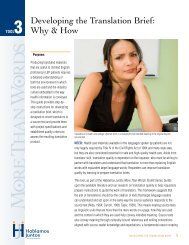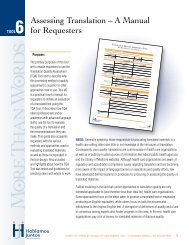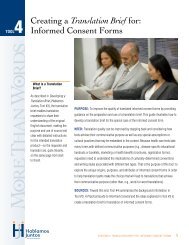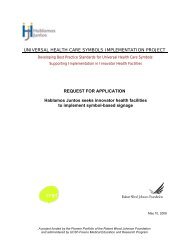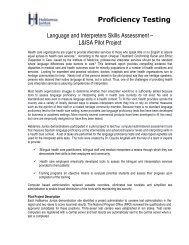universal symbols for healthcare environments - Hablamos Juntos
universal symbols for healthcare environments - Hablamos Juntos
universal symbols for healthcare environments - Hablamos Juntos
You also want an ePaper? Increase the reach of your titles
YUMPU automatically turns print PDFs into web optimized ePapers that Google loves.
17 Symbols Testing >87<br />
Surgery, Billing Department,<br />
Intensive Care Unit, Family<br />
Practice Clinic, Social Services<br />
Cardiology, Radiology, OB<br />
Clinic, Immunizations, Waiting<br />
Room<br />
Chapel, Ambulance Entrance,<br />
Pharmacy, Laboratory, Medical<br />
Records<br />
Pediatrics, Emergency<br />
11 Symbols Testing
Early on, the design team decided to maintain the look<br />
established by the Department of Transportaton <strong>symbols</strong> to<br />
maintain consistency when the new <strong>symbols</strong> would used in<br />
<br />
<br />
and San Francisco, Cali<strong>for</strong>nia. Tests were conducted with<br />
multi-lingual/multi-cultural groups to guage symbol<br />
recognition through matching tests, and site navigation using<br />
conjunction with existing <strong>symbols</strong>.<br />
various aids, including the <strong>symbols</strong> and maps.<br />
Existing <strong>symbols</strong>, along with newly designed <strong>symbols</strong><br />
<br />
<strong>Hablamos</strong> <strong>Juntos</strong> also conducted web-based matching<br />
(approximately 600 total), were collected and evaluated by<br />
the design team. For each referent, five to six <strong>symbols</strong> were<br />
<br />
<br />
<br />
<br />
<br />
<br />
tests. Both SEGD field tests and HJ’s testing supported the<br />
initial research and conclusions that <strong>symbols</strong> can be a viable<br />
chosen to be used in the first round of testing.<br />
means to aid communication and navigation within a health<br />
<br />
care environment.<br />
The <strong>symbols</strong> were subjected to comprehensibility estimation<br />
<br />
tests using a system developed by Harm Zwaga and adopted<br />
The full set of 28 <strong>symbols</strong> and their referents are illustrated<br />
by the International Organization <strong>for</strong> Standardization (ISO).<br />
on the following page. These <strong>symbols</strong> are being presented to<br />
The referent and its<br />
<br />
The Robert Wood Johnson Foundation as part of a complete<br />
<br />
<br />
<br />
<br />
definition were placed<br />
in the center of a five<br />
<br />
Technical Paper detailing the testing methods, test scores and<br />
recommendations <strong>for</strong> future symbol design.<br />
<br />
<br />
<br />
or six spoke “wheel”,<br />
<br />
<br />
<br />
<br />
with a symbol within<br />
<br />
The next step in the process will be to use the <strong>symbols</strong><br />
<br />
each spoke. The wheel<br />
<br />
within signage systems at three pilot sites to review<br />
<strong>Hablamos</strong> <strong>Juntos</strong>’ ten grantee sites –<br />
Olympia, Washington; Long Beach, Cali<strong>for</strong>nia;<br />
Grand Island, Nebraska; Fort Worth, Texas;<br />
Memphis, Tennessee; Hoover, Alabama; Philadelphia,<br />
was positioned so that<br />
no symbol was in a<br />
perceived “number one”<br />
position. (See Ex. 1)<br />
<br />
<br />
<br />
<br />
<br />
<br />
<br />
their effectiveness in everyday, real world, health care<br />
<strong>environments</strong>.<br />
SEGD and JRC Design will collaborate on a Best Practices<br />
Pennsylvania; Springfield, Virginia; Anderson,<br />
South Carolina; Providence, Rhode Island.<br />
Three rounds of tests<br />
Workbook <strong>for</strong> using the <strong>symbols</strong>. This workbook will include<br />
language translations <strong>for</strong> the referents, the <strong>symbols</strong> in digital<br />
were conducted <strong>for</strong> the referents. For each round, the grantee<br />
<br />
<strong>for</strong>mat, the testing results report and a national/international<br />
locations provided up to ten people (±100 total per round),<br />
meeting specific primary language criteria. Participants from<br />
four language groups were asked to estimate what percentage<br />
of the general population would understand each of the<br />
presented <strong>symbols</strong>. The results were recorded, the data entry<br />
verified and subsequently analyzed by the testing consultant<br />
on the project team.<br />
Symbols advanced to the next round of testing if they met<br />
a median estimate of >50. Symbols that achieved a median<br />
estimation >87 passed the comprehensibility test and could<br />
be considered “most meaningful” to the population tested.<br />
<br />
<br />
<br />
<br />
<br />
Ex. 2 Analysis sheet showing testing results provided to the design team.<br />
had at least one symbol that met the >87 score. This<br />
allowed the design team to select <strong>symbols</strong> that not only<br />
met comprehensibility standards but also best fit a cohesive<br />
looking system. The eleven referents without any <strong>symbols</strong><br />
meeting that criteria were reviewed and evaluated by the<br />
design team. Options <strong>for</strong> the eleven were reviewed against<br />
the seventeen <strong>symbols</strong> that did pass, in order to determine<br />
which elements within the meaninful <strong>symbols</strong> seemed to aid<br />
the public’s comprehension. An option <strong>for</strong> each referent was<br />
then selected and refined to match the overall symbol set.<br />
rollout campaign <strong>for</strong> educational purposes. These <strong>symbols</strong> will<br />
be become public domain upon release, thanks to The Robert<br />
Wood Johnson Foundation.<br />
The team’s wish is that additional needed <strong>symbols</strong> continue<br />
to be tested through these proven methodologies and<br />
accepted into the standards <strong>for</strong> use, not only in the United<br />
States but throughout the world, as <strong>universal</strong> public<br />
in<strong>for</strong>mation <strong>symbols</strong> in the health care environment.<br />
A complete report of testing procedures with results <strong>for</strong> each<br />
symbol is available at www.hablamosjuntos.org.<br />
In addition to statistical summaries, the results were<br />
presented on analysis sheets that would allow the team to<br />
view most meaningful <strong>symbols</strong> and compare their image<br />
content. (See Ex. 2) Seventeen of the twenty-eight referents<br />
Ex. 1 EMERGENCY – Rounds 1, 2, and 3 test wheels.<br />
Additionally, field testing was conducted by SEGD. This<br />
included recognition and navigational testing at four health<br />
care facilities located throughout the country: Somerville,<br />
Massachusetts; Grand Island, Nebraska; Atlanta, Georgia


